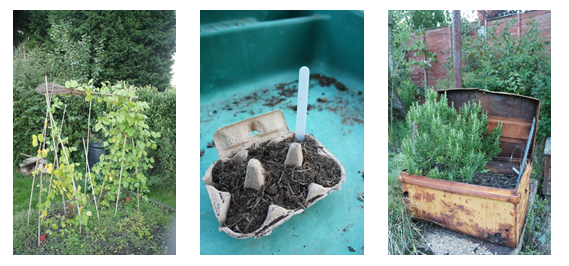Turn your trash into treasure
If you’re selling your property, we would always recommend having a good declutter of your home to create a blank canvas so potential buyers can imagine living there with their possessions.
But before you head straight to the rubbish bin with your old belongings, have a think… you could be throwing away a home for nature that’s just waiting to be transformed.
But before you head straight to the rubbish bin with your old belongings, have a think… you could be throwing away a home for nature that’s just waiting to be transformed.

Starting small
No matter how big or small your outside space, growing plants in containers is a great way of providing wildlife with a tasty treat or somewhere safe to hide. And the good news is you don’t need to buy expensive plant pots – there’s lots of every day items that will do the job just as well. Everything from old wellie boots and tin cans to colanders that have seen better days and, in our case, an old trunk can be used to grow plants in. Just make sure there’s good drainage (either with some holes in the bottom or a layer of pine cones or stones under the soil), otherwise your plants can get water logged.
You can even recycle taller objects to give climbers, like honeysuckle, a helping hand. Old CD towers, ladders or even mangles can help provide support to your mini sky scrapers for nature.
Recycled water feature
It’s not just plants that can benefit – you can turn a whole host of old containers into mini ponds so give your old washing up bowls, buckets, and Belfast sinks a new lease of life and provide your garden wildlife with its very own watering hole. More on this next week!
Rubbish revisited
You can even use everyday “rubbish” to turn your garden into a haven for nature. Old plastic drinks bottles can be transformed into DIY bird feeders. Egg shells and egg boxes can be used as cheap and cheerful starter plant pots for growing seeds. You can cut the bottom off plastic bottles and put them neck first into the soil by your plants to make sure you get right to the roots when you’re watering. You can even turn an old cardboard box into a compostarium and here’s how…
 Make your own compostarium
Make your own compostarium
You’ll need:
A cardboard box, compostable material like potato peelings, apple cores and a little scrunched up newspaper, and some small stones.
1. Open the cardboard box at both ends, watching out for any sharp staples.
2. Find a sheltered spot in the garden and put your box upside down with the flaps outwards. Weigh the flaps down with small stones.
3. Fill your compostarium with the compostable material. It needs to stay moist, so water it regularly, but only with a little water so your box doesn’t get soggy.
4. Keep the lid closed with something light, like a branch. The compostarium needs to stay covered and humid inside.
5. Check every so often to see what compost creepie crawlies are feeding inside.
6. After a while, the cardboard box will collapse. Just dig a hole and bury it. All the animals inside will escape and your box will turn to compost.
We’d love to hear about any other ideas you’ve got about how to give nature a home by decluttering yours.
Artwork by Anthony Rule and compostarium activity taken from RSPB Bird Life magazine.
For more ways on how to give nature a home in your garden and to download your free guide, visit rspb.org.uk/homes

 We all know there is a housing crisis in the UK. Perhaps less well-known, however, is that there is an equally urgent housing crisis facing much of the UK’s threatened wildlife.
We all know there is a housing crisis in the UK. Perhaps less well-known, however, is that there is an equally urgent housing crisis facing much of the UK’s threatened wildlife.
The worrying state of things for creatures that call our gardens ‘home’ has encouraged Rightmove to lend our support to the RSPB’s new Giving Nature a Home campaign. The objective is simple: to encourage people across the UK to create a million new homes for nature in their gardens and outdoor spaces.


